Comprehensive Analysis of Brand Management and Brand Equity Building
VerifiedAdded on 2024/06/11
|23
|6052
|272
Report
AI Summary
This report provides a comprehensive analysis of brand management, focusing on building and managing brand equity. It discusses the importance of branding as a marketing tool, key components of a successful brand strategy, and how brands are managed over time using models like Keller's Brand Equity Model and Aaker's Brand Equity Model. The report also examines portfolio management strategies, brand hierarchies, brand equity management, and collaborative partnerships, using examples like Toyota. Furthermore, it evaluates techniques for measuring and managing brand value, highlighting the importance of a strong and enduring brand. This document is available on Desklib, a platform offering study tools and resources for students.

Brand Management
Paraphrase This Document
Need a fresh take? Get an instant paraphrase of this document with our AI Paraphraser
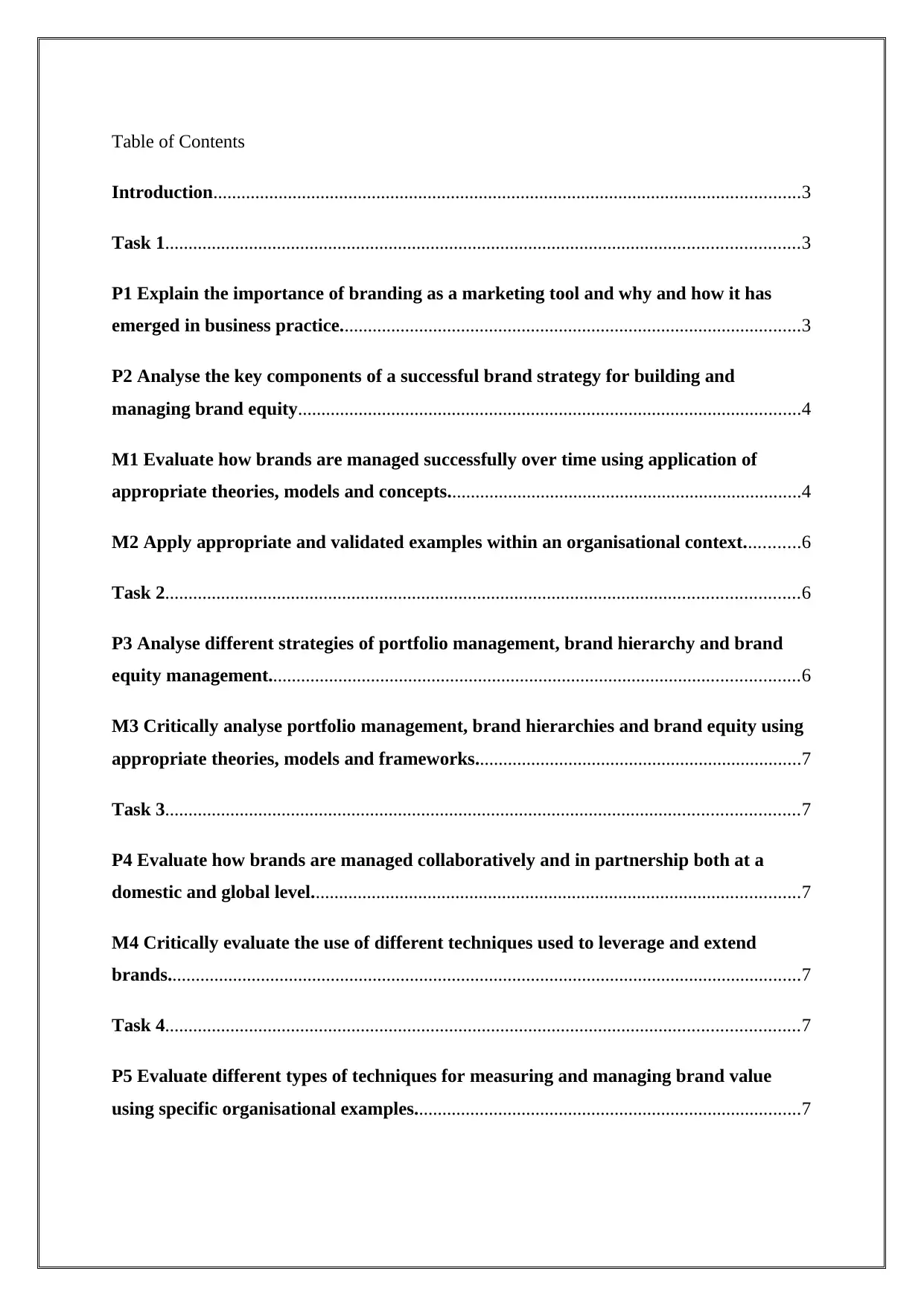
Table of Contents
Introduction..............................................................................................................................3
Task 1........................................................................................................................................3
P1 Explain the importance of branding as a marketing tool and why and how it has
emerged in business practice...................................................................................................3
P2 Analyse the key components of a successful brand strategy for building and
managing brand equity............................................................................................................4
M1 Evaluate how brands are managed successfully over time using application of
appropriate theories, models and concepts............................................................................4
M2 Apply appropriate and validated examples within an organisational context............6
Task 2........................................................................................................................................6
P3 Analyse different strategies of portfolio management, brand hierarchy and brand
equity management..................................................................................................................6
M3 Critically analyse portfolio management, brand hierarchies and brand equity using
appropriate theories, models and frameworks......................................................................7
Task 3........................................................................................................................................7
P4 Evaluate how brands are managed collaboratively and in partnership both at a
domestic and global level.........................................................................................................7
M4 Critically evaluate the use of different techniques used to leverage and extend
brands........................................................................................................................................7
Task 4........................................................................................................................................7
P5 Evaluate different types of techniques for measuring and managing brand value
using specific organisational examples...................................................................................7
Introduction..............................................................................................................................3
Task 1........................................................................................................................................3
P1 Explain the importance of branding as a marketing tool and why and how it has
emerged in business practice...................................................................................................3
P2 Analyse the key components of a successful brand strategy for building and
managing brand equity............................................................................................................4
M1 Evaluate how brands are managed successfully over time using application of
appropriate theories, models and concepts............................................................................4
M2 Apply appropriate and validated examples within an organisational context............6
Task 2........................................................................................................................................6
P3 Analyse different strategies of portfolio management, brand hierarchy and brand
equity management..................................................................................................................6
M3 Critically analyse portfolio management, brand hierarchies and brand equity using
appropriate theories, models and frameworks......................................................................7
Task 3........................................................................................................................................7
P4 Evaluate how brands are managed collaboratively and in partnership both at a
domestic and global level.........................................................................................................7
M4 Critically evaluate the use of different techniques used to leverage and extend
brands........................................................................................................................................7
Task 4........................................................................................................................................7
P5 Evaluate different types of techniques for measuring and managing brand value
using specific organisational examples...................................................................................7
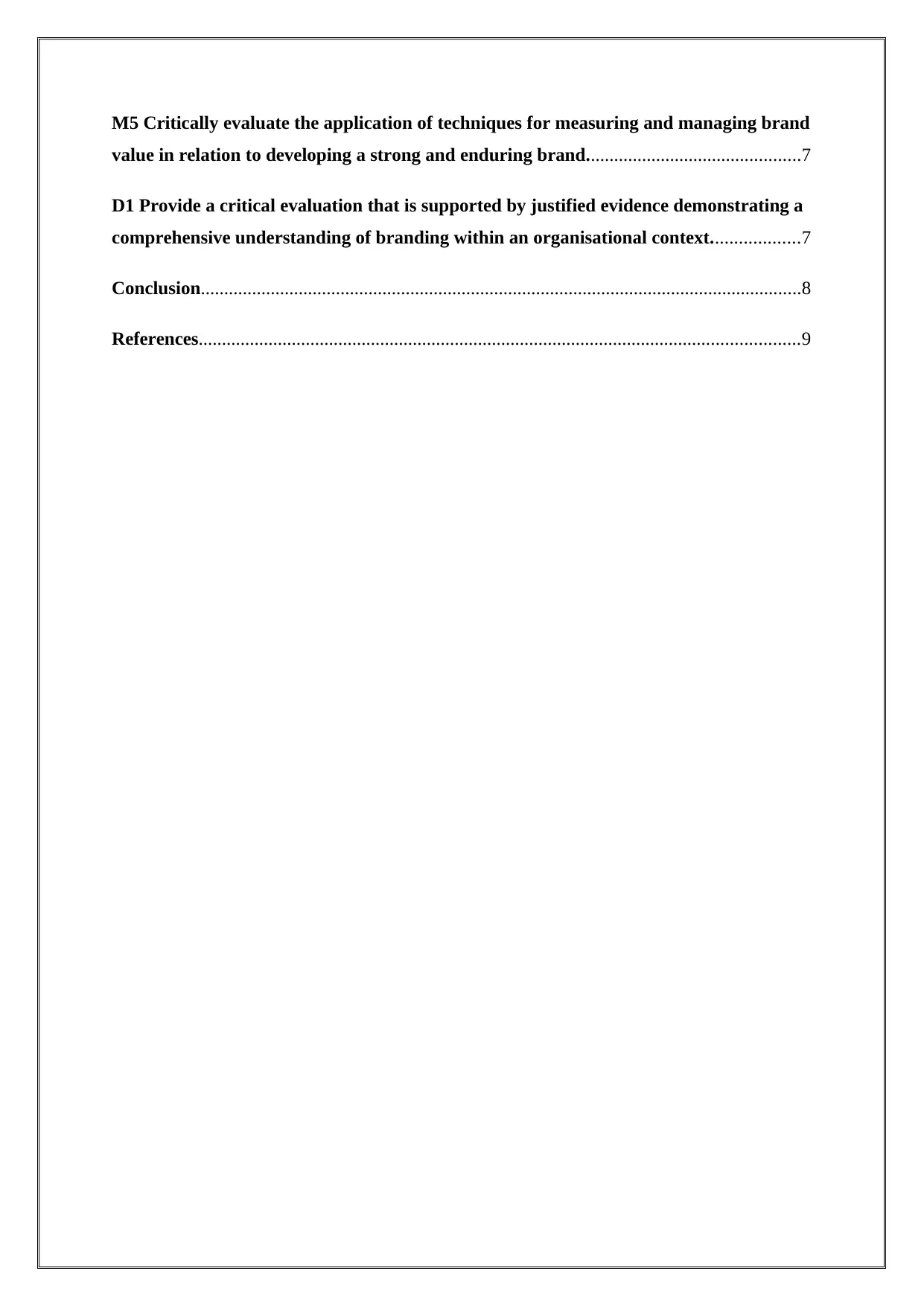
M5 Critically evaluate the application of techniques for measuring and managing brand
value in relation to developing a strong and enduring brand..............................................7
D1 Provide a critical evaluation that is supported by justified evidence demonstrating a
comprehensive understanding of branding within an organisational context...................7
Conclusion.................................................................................................................................8
References.................................................................................................................................9
value in relation to developing a strong and enduring brand..............................................7
D1 Provide a critical evaluation that is supported by justified evidence demonstrating a
comprehensive understanding of branding within an organisational context...................7
Conclusion.................................................................................................................................8
References.................................................................................................................................9
⊘ This is a preview!⊘
Do you want full access?
Subscribe today to unlock all pages.

Trusted by 1+ million students worldwide
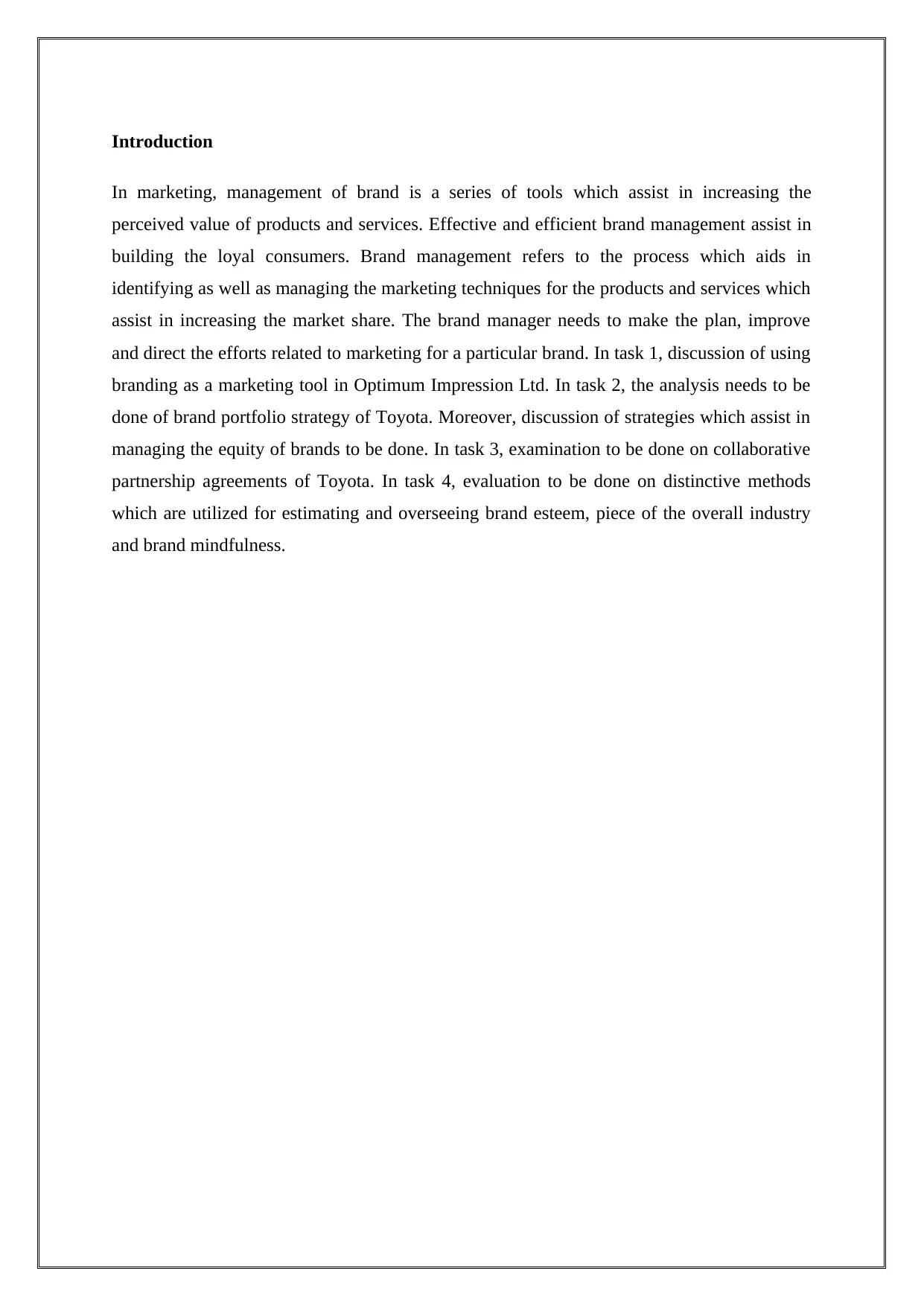
Introduction
In marketing, management of brand is a series of tools which assist in increasing the
perceived value of products and services. Effective and efficient brand management assist in
building the loyal consumers. Brand management refers to the process which aids in
identifying as well as managing the marketing techniques for the products and services which
assist in increasing the market share. The brand manager needs to make the plan, improve
and direct the efforts related to marketing for a particular brand. In task 1, discussion of using
branding as a marketing tool in Optimum Impression Ltd. In task 2, the analysis needs to be
done of brand portfolio strategy of Toyota. Moreover, discussion of strategies which assist in
managing the equity of brands to be done. In task 3, examination to be done on collaborative
partnership agreements of Toyota. In task 4, evaluation to be done on distinctive methods
which are utilized for estimating and overseeing brand esteem, piece of the overall industry
and brand mindfulness.
In marketing, management of brand is a series of tools which assist in increasing the
perceived value of products and services. Effective and efficient brand management assist in
building the loyal consumers. Brand management refers to the process which aids in
identifying as well as managing the marketing techniques for the products and services which
assist in increasing the market share. The brand manager needs to make the plan, improve
and direct the efforts related to marketing for a particular brand. In task 1, discussion of using
branding as a marketing tool in Optimum Impression Ltd. In task 2, the analysis needs to be
done of brand portfolio strategy of Toyota. Moreover, discussion of strategies which assist in
managing the equity of brands to be done. In task 3, examination to be done on collaborative
partnership agreements of Toyota. In task 4, evaluation to be done on distinctive methods
which are utilized for estimating and overseeing brand esteem, piece of the overall industry
and brand mindfulness.
Paraphrase This Document
Need a fresh take? Get an instant paraphrase of this document with our AI Paraphraser
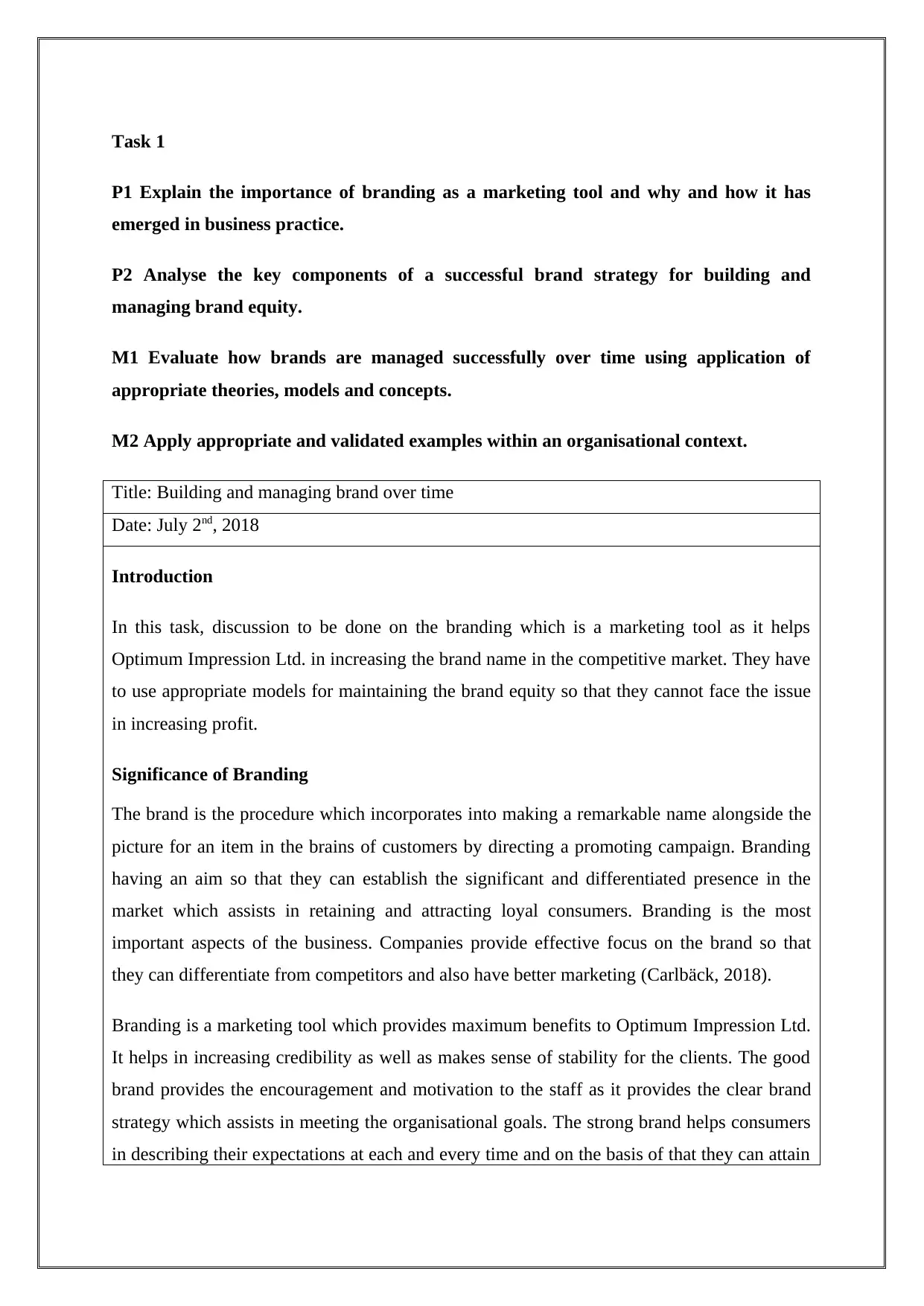
Task 1
P1 Explain the importance of branding as a marketing tool and why and how it has
emerged in business practice.
P2 Analyse the key components of a successful brand strategy for building and
managing brand equity.
M1 Evaluate how brands are managed successfully over time using application of
appropriate theories, models and concepts.
M2 Apply appropriate and validated examples within an organisational context.
Title: Building and managing brand over time
Date: July 2nd, 2018
Introduction
In this task, discussion to be done on the branding which is a marketing tool as it helps
Optimum Impression Ltd. in increasing the brand name in the competitive market. They have
to use appropriate models for maintaining the brand equity so that they cannot face the issue
in increasing profit.
Significance of Branding
The brand is the procedure which incorporates into making a remarkable name alongside the
picture for an item in the brains of customers by directing a promoting campaign. Branding
having an aim so that they can establish the significant and differentiated presence in the
market which assists in retaining and attracting loyal consumers. Branding is the most
important aspects of the business. Companies provide effective focus on the brand so that
they can differentiate from competitors and also have better marketing (Carlbäck, 2018).
Branding is a marketing tool which provides maximum benefits to Optimum Impression Ltd.
It helps in increasing credibility as well as makes sense of stability for the clients. The good
brand provides the encouragement and motivation to the staff as it provides the clear brand
strategy which assists in meeting the organisational goals. The strong brand helps consumers
in describing their expectations at each and every time and on the basis of that they can attain
P1 Explain the importance of branding as a marketing tool and why and how it has
emerged in business practice.
P2 Analyse the key components of a successful brand strategy for building and
managing brand equity.
M1 Evaluate how brands are managed successfully over time using application of
appropriate theories, models and concepts.
M2 Apply appropriate and validated examples within an organisational context.
Title: Building and managing brand over time
Date: July 2nd, 2018
Introduction
In this task, discussion to be done on the branding which is a marketing tool as it helps
Optimum Impression Ltd. in increasing the brand name in the competitive market. They have
to use appropriate models for maintaining the brand equity so that they cannot face the issue
in increasing profit.
Significance of Branding
The brand is the procedure which incorporates into making a remarkable name alongside the
picture for an item in the brains of customers by directing a promoting campaign. Branding
having an aim so that they can establish the significant and differentiated presence in the
market which assists in retaining and attracting loyal consumers. Branding is the most
important aspects of the business. Companies provide effective focus on the brand so that
they can differentiate from competitors and also have better marketing (Carlbäck, 2018).
Branding is a marketing tool which provides maximum benefits to Optimum Impression Ltd.
It helps in increasing credibility as well as makes sense of stability for the clients. The good
brand provides the encouragement and motivation to the staff as it provides the clear brand
strategy which assists in meeting the organisational goals. The strong brand helps consumers
in describing their expectations at each and every time and on the basis of that they can attain
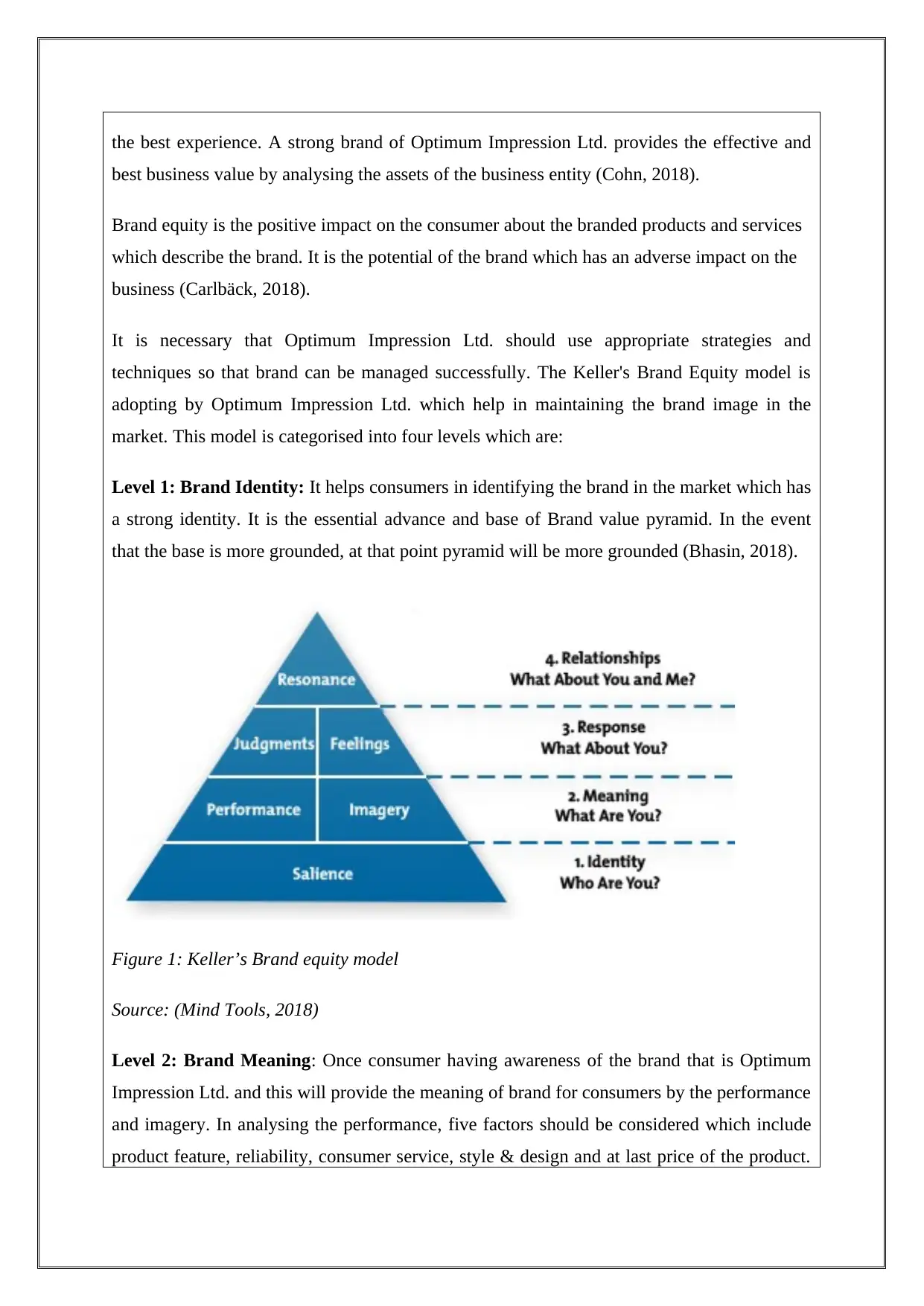
the best experience. A strong brand of Optimum Impression Ltd. provides the effective and
best business value by analysing the assets of the business entity (Cohn, 2018).
Brand equity is the positive impact on the consumer about the branded products and services
which describe the brand. It is the potential of the brand which has an adverse impact on the
business (Carlbäck, 2018).
It is necessary that Optimum Impression Ltd. should use appropriate strategies and
techniques so that brand can be managed successfully. The Keller's Brand Equity model is
adopting by Optimum Impression Ltd. which help in maintaining the brand image in the
market. This model is categorised into four levels which are:
Level 1: Brand Identity: It helps consumers in identifying the brand in the market which has
a strong identity. It is the essential advance and base of Brand value pyramid. In the event
that the base is more grounded, at that point pyramid will be more grounded (Bhasin, 2018).
Figure 1: Keller’s Brand equity model
Source: (Mind Tools, 2018)
Level 2: Brand Meaning: Once consumer having awareness of the brand that is Optimum
Impression Ltd. and this will provide the meaning of brand for consumers by the performance
and imagery. In analysing the performance, five factors should be considered which include
product feature, reliability, consumer service, style & design and at last price of the product.
best business value by analysing the assets of the business entity (Cohn, 2018).
Brand equity is the positive impact on the consumer about the branded products and services
which describe the brand. It is the potential of the brand which has an adverse impact on the
business (Carlbäck, 2018).
It is necessary that Optimum Impression Ltd. should use appropriate strategies and
techniques so that brand can be managed successfully. The Keller's Brand Equity model is
adopting by Optimum Impression Ltd. which help in maintaining the brand image in the
market. This model is categorised into four levels which are:
Level 1: Brand Identity: It helps consumers in identifying the brand in the market which has
a strong identity. It is the essential advance and base of Brand value pyramid. In the event
that the base is more grounded, at that point pyramid will be more grounded (Bhasin, 2018).
Figure 1: Keller’s Brand equity model
Source: (Mind Tools, 2018)
Level 2: Brand Meaning: Once consumer having awareness of the brand that is Optimum
Impression Ltd. and this will provide the meaning of brand for consumers by the performance
and imagery. In analysing the performance, five factors should be considered which include
product feature, reliability, consumer service, style & design and at last price of the product.
⊘ This is a preview!⊘
Do you want full access?
Subscribe today to unlock all pages.

Trusted by 1+ million students worldwide

Brand imagery includes target marketing and word of mouth which assist in building the
strong image in the market.
Level 3: Brand Response: According to this model, brand which having more feeling than
the judgementsthat it is a brand which helps with building brand value. In this way, the
reaction of brand is higher and more than the brand value pyramid.
Level 4: Brand Resonance: This level includes some factors which are related to brand
resonance include behaviour, value, engagement of consumers and last is connection and
feelings.
Key Components
The main concept of the brand strategyincludes brand attribute, positioning, identity,
personality, awareness and association as it assists in building and managing the brand
equity. It includes:
Brand attribute: It denotes the core values as well as represent the essence of a brand. It
includes the set of characteristics which assist in identifying the physical, character as well as
personality traits of a brand.
Brand positioning: It refers to the art as well as science which help in fitting the products
into different segments of the broad market. There are some basic qualities of brand
positioning include relevancy, coherence, clarity, courage and commitment (Tomczak, et. al.,
2018).
Brand identity: The brand image is the manner by which company present themselves in
front of the public. This denotes the Optimum Impression Ltd. uniqueness in terms of
products and services.
Brand personality: It is an arrangement of human qualities which are ascribed to a brand
name. The brand increases with its brand equity and it is classified into different segments
which are competence, sophistication, ruggedness, sincerity and excitement.
Brand awareness: It describes the ability of consumers to recognise the brand under the
diversified conditions and it is linked with the brand name or logo (Mayur, 2017).
strong image in the market.
Level 3: Brand Response: According to this model, brand which having more feeling than
the judgementsthat it is a brand which helps with building brand value. In this way, the
reaction of brand is higher and more than the brand value pyramid.
Level 4: Brand Resonance: This level includes some factors which are related to brand
resonance include behaviour, value, engagement of consumers and last is connection and
feelings.
Key Components
The main concept of the brand strategyincludes brand attribute, positioning, identity,
personality, awareness and association as it assists in building and managing the brand
equity. It includes:
Brand attribute: It denotes the core values as well as represent the essence of a brand. It
includes the set of characteristics which assist in identifying the physical, character as well as
personality traits of a brand.
Brand positioning: It refers to the art as well as science which help in fitting the products
into different segments of the broad market. There are some basic qualities of brand
positioning include relevancy, coherence, clarity, courage and commitment (Tomczak, et. al.,
2018).
Brand identity: The brand image is the manner by which company present themselves in
front of the public. This denotes the Optimum Impression Ltd. uniqueness in terms of
products and services.
Brand personality: It is an arrangement of human qualities which are ascribed to a brand
name. The brand increases with its brand equity and it is classified into different segments
which are competence, sophistication, ruggedness, sincerity and excitement.
Brand awareness: It describes the ability of consumers to recognise the brand under the
diversified conditions and it is linked with the brand name or logo (Mayur, 2017).
Paraphrase This Document
Need a fresh take? Get an instant paraphrase of this document with our AI Paraphraser
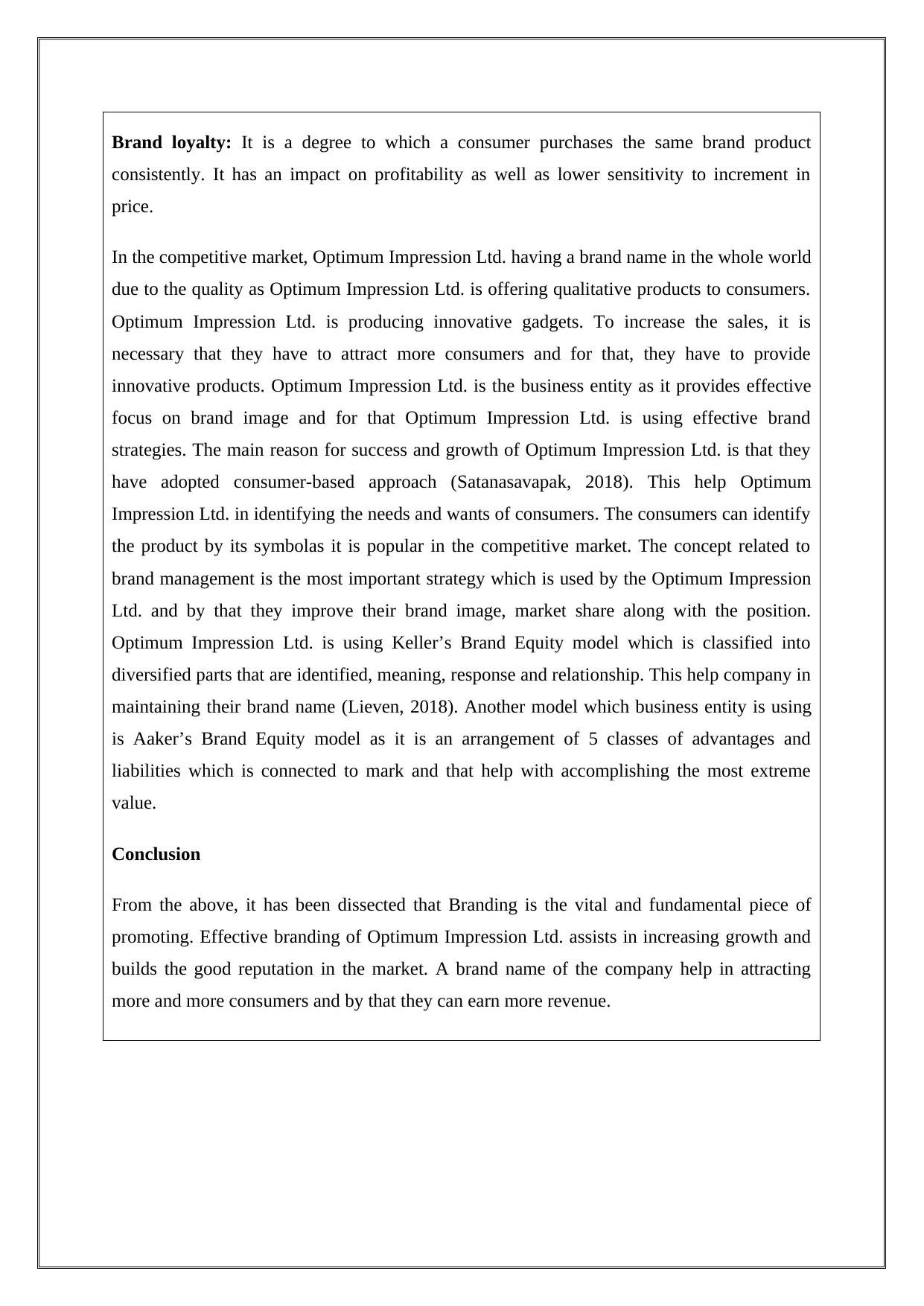
Brand loyalty: It is a degree to which a consumer purchases the same brand product
consistently. It has an impact on profitability as well as lower sensitivity to increment in
price.
In the competitive market, Optimum Impression Ltd. having a brand name in the whole world
due to the quality as Optimum Impression Ltd. is offering qualitative products to consumers.
Optimum Impression Ltd. is producing innovative gadgets. To increase the sales, it is
necessary that they have to attract more consumers and for that, they have to provide
innovative products. Optimum Impression Ltd. is the business entity as it provides effective
focus on brand image and for that Optimum Impression Ltd. is using effective brand
strategies. The main reason for success and growth of Optimum Impression Ltd. is that they
have adopted consumer-based approach (Satanasavapak, 2018). This help Optimum
Impression Ltd. in identifying the needs and wants of consumers. The consumers can identify
the product by its symbolas it is popular in the competitive market. The concept related to
brand management is the most important strategy which is used by the Optimum Impression
Ltd. and by that they improve their brand image, market share along with the position.
Optimum Impression Ltd. is using Keller’s Brand Equity model which is classified into
diversified parts that are identified, meaning, response and relationship. This help company in
maintaining their brand name (Lieven, 2018). Another model which business entity is using
is Aaker’s Brand Equity model as it is an arrangement of 5 classes of advantages and
liabilities which is connected to mark and that help with accomplishing the most extreme
value.
Conclusion
From the above, it has been dissected that Branding is the vital and fundamental piece of
promoting. Effective branding of Optimum Impression Ltd. assists in increasing growth and
builds the good reputation in the market. A brand name of the company help in attracting
more and more consumers and by that they can earn more revenue.
consistently. It has an impact on profitability as well as lower sensitivity to increment in
price.
In the competitive market, Optimum Impression Ltd. having a brand name in the whole world
due to the quality as Optimum Impression Ltd. is offering qualitative products to consumers.
Optimum Impression Ltd. is producing innovative gadgets. To increase the sales, it is
necessary that they have to attract more consumers and for that, they have to provide
innovative products. Optimum Impression Ltd. is the business entity as it provides effective
focus on brand image and for that Optimum Impression Ltd. is using effective brand
strategies. The main reason for success and growth of Optimum Impression Ltd. is that they
have adopted consumer-based approach (Satanasavapak, 2018). This help Optimum
Impression Ltd. in identifying the needs and wants of consumers. The consumers can identify
the product by its symbolas it is popular in the competitive market. The concept related to
brand management is the most important strategy which is used by the Optimum Impression
Ltd. and by that they improve their brand image, market share along with the position.
Optimum Impression Ltd. is using Keller’s Brand Equity model which is classified into
diversified parts that are identified, meaning, response and relationship. This help company in
maintaining their brand name (Lieven, 2018). Another model which business entity is using
is Aaker’s Brand Equity model as it is an arrangement of 5 classes of advantages and
liabilities which is connected to mark and that help with accomplishing the most extreme
value.
Conclusion
From the above, it has been dissected that Branding is the vital and fundamental piece of
promoting. Effective branding of Optimum Impression Ltd. assists in increasing growth and
builds the good reputation in the market. A brand name of the company help in attracting
more and more consumers and by that they can earn more revenue.
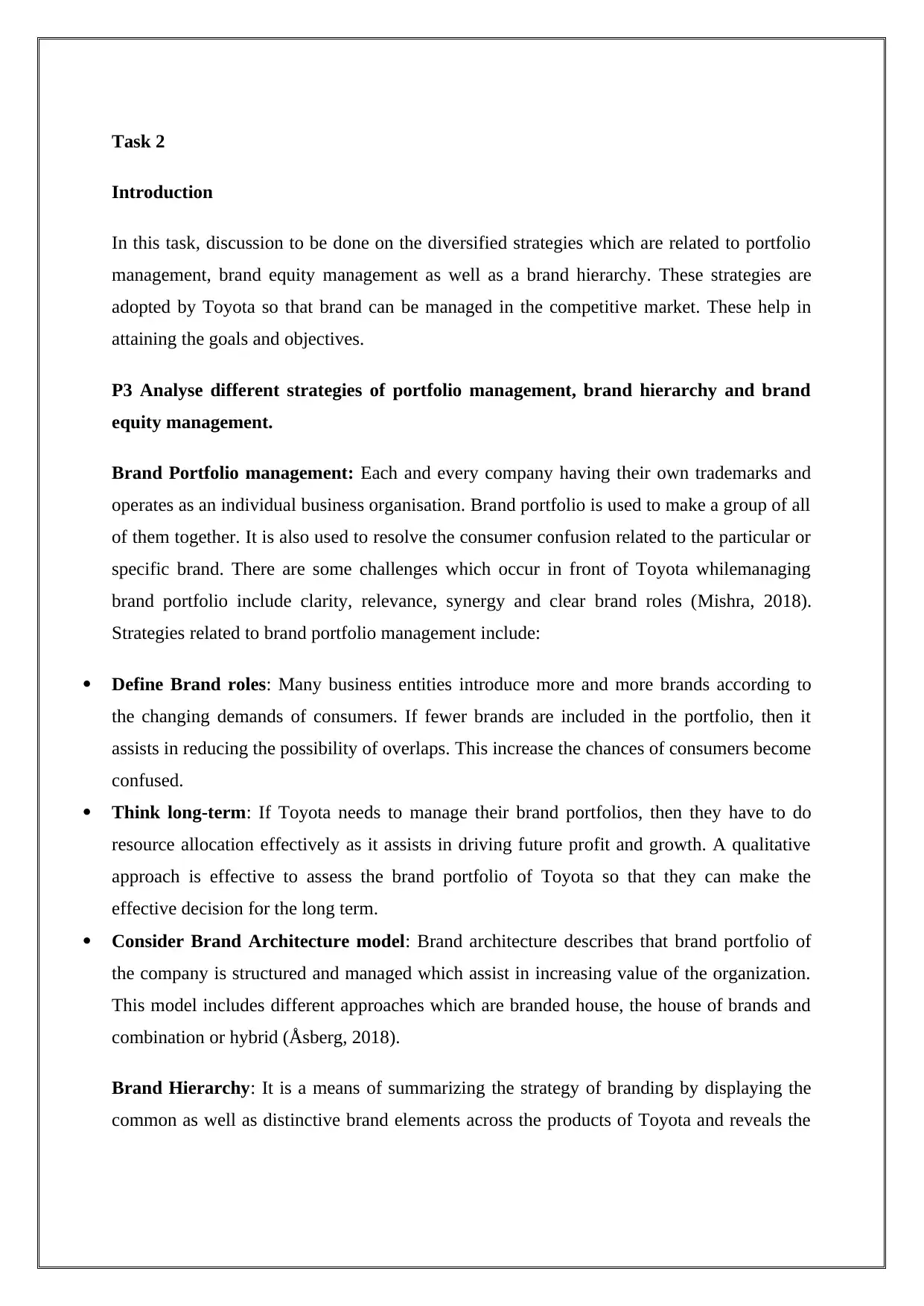
Task 2
Introduction
In this task, discussion to be done on the diversified strategies which are related to portfolio
management, brand equity management as well as a brand hierarchy. These strategies are
adopted by Toyota so that brand can be managed in the competitive market. These help in
attaining the goals and objectives.
P3 Analyse different strategies of portfolio management, brand hierarchy and brand
equity management.
Brand Portfolio management: Each and every company having their own trademarks and
operates as an individual business organisation. Brand portfolio is used to make a group of all
of them together. It is also used to resolve the consumer confusion related to the particular or
specific brand. There are some challenges which occur in front of Toyota whilemanaging
brand portfolio include clarity, relevance, synergy and clear brand roles (Mishra, 2018).
Strategies related to brand portfolio management include:
Define Brand roles: Many business entities introduce more and more brands according to
the changing demands of consumers. If fewer brands are included in the portfolio, then it
assists in reducing the possibility of overlaps. This increase the chances of consumers become
confused.
Think long-term: If Toyota needs to manage their brand portfolios, then they have to do
resource allocation effectively as it assists in driving future profit and growth. A qualitative
approach is effective to assess the brand portfolio of Toyota so that they can make the
effective decision for the long term.
Consider Brand Architecture model: Brand architecture describes that brand portfolio of
the company is structured and managed which assist in increasing value of the organization.
This model includes different approaches which are branded house, the house of brands and
combination or hybrid (Åsberg, 2018).
Brand Hierarchy: It is a means of summarizing the strategy of branding by displaying the
common as well as distinctive brand elements across the products of Toyota and reveals the
Introduction
In this task, discussion to be done on the diversified strategies which are related to portfolio
management, brand equity management as well as a brand hierarchy. These strategies are
adopted by Toyota so that brand can be managed in the competitive market. These help in
attaining the goals and objectives.
P3 Analyse different strategies of portfolio management, brand hierarchy and brand
equity management.
Brand Portfolio management: Each and every company having their own trademarks and
operates as an individual business organisation. Brand portfolio is used to make a group of all
of them together. It is also used to resolve the consumer confusion related to the particular or
specific brand. There are some challenges which occur in front of Toyota whilemanaging
brand portfolio include clarity, relevance, synergy and clear brand roles (Mishra, 2018).
Strategies related to brand portfolio management include:
Define Brand roles: Many business entities introduce more and more brands according to
the changing demands of consumers. If fewer brands are included in the portfolio, then it
assists in reducing the possibility of overlaps. This increase the chances of consumers become
confused.
Think long-term: If Toyota needs to manage their brand portfolios, then they have to do
resource allocation effectively as it assists in driving future profit and growth. A qualitative
approach is effective to assess the brand portfolio of Toyota so that they can make the
effective decision for the long term.
Consider Brand Architecture model: Brand architecture describes that brand portfolio of
the company is structured and managed which assist in increasing value of the organization.
This model includes different approaches which are branded house, the house of brands and
combination or hybrid (Åsberg, 2018).
Brand Hierarchy: It is a means of summarizing the strategy of branding by displaying the
common as well as distinctive brand elements across the products of Toyota and reveals the
⊘ This is a preview!⊘
Do you want full access?
Subscribe today to unlock all pages.

Trusted by 1+ million students worldwide

explicit ordering of elements associated to the brand. It is necessary that manager of Toyota
need to adopt appropriate strategies for creating awareness. Strategies include:
Individual product branding:It is a strategy in which brand name of the product is created
and not connected with the existing brand.
Corporate branding: It is a type of strategy related to management hierarchy which helps in
a link the name with the efforts related to promotional activities which attract more
consumers (Romano, et. al., 2018).
It provides a contribution in articulating the worth of products and services of Toyota in the
competitive market.
Brand equity management: In the market, all brands having some measure of brand equity
and Toyota have a strong brand equity. It is a factor which assists in attracting consumers.
The strategies of brand equity include communication, reputation, awareness, legal as well as
ethical decision making, collaboration and value. The brand equity of Toyota can be managed
by using Aaker’s Brand Equity Model. This model having five components which include:
Brand Loyalty: It includes different factors which are reducing costs, trade leverage or
bringing the new consumers.
Brand Awareness: It also involved different factors which help in extending brand name and
that are familiarity, substantiality and consumers consideration (Roper, et. al., 2018).
Perceived Quality: It is a type of strategy which helps Toyota in offering appropriate
andeffective quality products. It includes quality, brand position, price and wide availability.
Brand Association: It is a degree by which particular product can be recognized within its
category. It includes drive purchasing, attitude and information retrieval.
Proprietary Assets: It includes patents, trademarks and other intellectual property rights as it
helps in enhancing the brand image of Toyota in the market (Sinclair-Maragh, 2018).
need to adopt appropriate strategies for creating awareness. Strategies include:
Individual product branding:It is a strategy in which brand name of the product is created
and not connected with the existing brand.
Corporate branding: It is a type of strategy related to management hierarchy which helps in
a link the name with the efforts related to promotional activities which attract more
consumers (Romano, et. al., 2018).
It provides a contribution in articulating the worth of products and services of Toyota in the
competitive market.
Brand equity management: In the market, all brands having some measure of brand equity
and Toyota have a strong brand equity. It is a factor which assists in attracting consumers.
The strategies of brand equity include communication, reputation, awareness, legal as well as
ethical decision making, collaboration and value. The brand equity of Toyota can be managed
by using Aaker’s Brand Equity Model. This model having five components which include:
Brand Loyalty: It includes different factors which are reducing costs, trade leverage or
bringing the new consumers.
Brand Awareness: It also involved different factors which help in extending brand name and
that are familiarity, substantiality and consumers consideration (Roper, et. al., 2018).
Perceived Quality: It is a type of strategy which helps Toyota in offering appropriate
andeffective quality products. It includes quality, brand position, price and wide availability.
Brand Association: It is a degree by which particular product can be recognized within its
category. It includes drive purchasing, attitude and information retrieval.
Proprietary Assets: It includes patents, trademarks and other intellectual property rights as it
helps in enhancing the brand image of Toyota in the market (Sinclair-Maragh, 2018).
Paraphrase This Document
Need a fresh take? Get an instant paraphrase of this document with our AI Paraphraser

M3 Critically analyse portfolio management, brand hierarchies and brand equity using
appropriate theories, models and frameworks.
In the lights of Baker (2014), it has been analysed that management of the portfolio is
necessary for Toyota as it assists in making the effective decision for the investment as well
as assist in managing the risk so that performance can be enhanced. It is necessary that brand
has a well-defined role which provides the contribution in attaining success in the market.
According to Cornelissen and Cornelissen (2017), it has been reviewed that brand hierarchy
includes the vision and mission statement and the different methods which assist in
increasing number of customers. When Toyota is using Brand hierarchy then, it decreases the
competitive advantage.
In the viewpoints of Detlef (2016), it has been evaluated that brand equity having four
components which include differentiation, knowledge, relevance and esteem.Brand managers
of Toyota are responsible for implementing the strategies which assist in enhancing the brand
equity without damaging any reputation of a brand as well as the profitability of Toyota. The
strategies of brand equity which Toyota can adapt to maintain their brand name in the market.
Strategies include create a recognized brand, adopt effective and best communication
strategy. It is necessary that Toyota needs to maintain the reputation in the competitive
market which assists in attaining maximum revenue and attract more consumers.
Conclusion
From the above, it has been analysed that Toyota should implement the appropriate and
effective strategies so that portfolio of the brand can be managed for a long term and this will
assist in retaining the consumers as well. The employees of Toyota need to fulfil the roles and
responsibilities so that awareness can be created.
appropriate theories, models and frameworks.
In the lights of Baker (2014), it has been analysed that management of the portfolio is
necessary for Toyota as it assists in making the effective decision for the investment as well
as assist in managing the risk so that performance can be enhanced. It is necessary that brand
has a well-defined role which provides the contribution in attaining success in the market.
According to Cornelissen and Cornelissen (2017), it has been reviewed that brand hierarchy
includes the vision and mission statement and the different methods which assist in
increasing number of customers. When Toyota is using Brand hierarchy then, it decreases the
competitive advantage.
In the viewpoints of Detlef (2016), it has been evaluated that brand equity having four
components which include differentiation, knowledge, relevance and esteem.Brand managers
of Toyota are responsible for implementing the strategies which assist in enhancing the brand
equity without damaging any reputation of a brand as well as the profitability of Toyota. The
strategies of brand equity which Toyota can adapt to maintain their brand name in the market.
Strategies include create a recognized brand, adopt effective and best communication
strategy. It is necessary that Toyota needs to maintain the reputation in the competitive
market which assists in attaining maximum revenue and attract more consumers.
Conclusion
From the above, it has been analysed that Toyota should implement the appropriate and
effective strategies so that portfolio of the brand can be managed for a long term and this will
assist in retaining the consumers as well. The employees of Toyota need to fulfil the roles and
responsibilities so that awareness can be created.
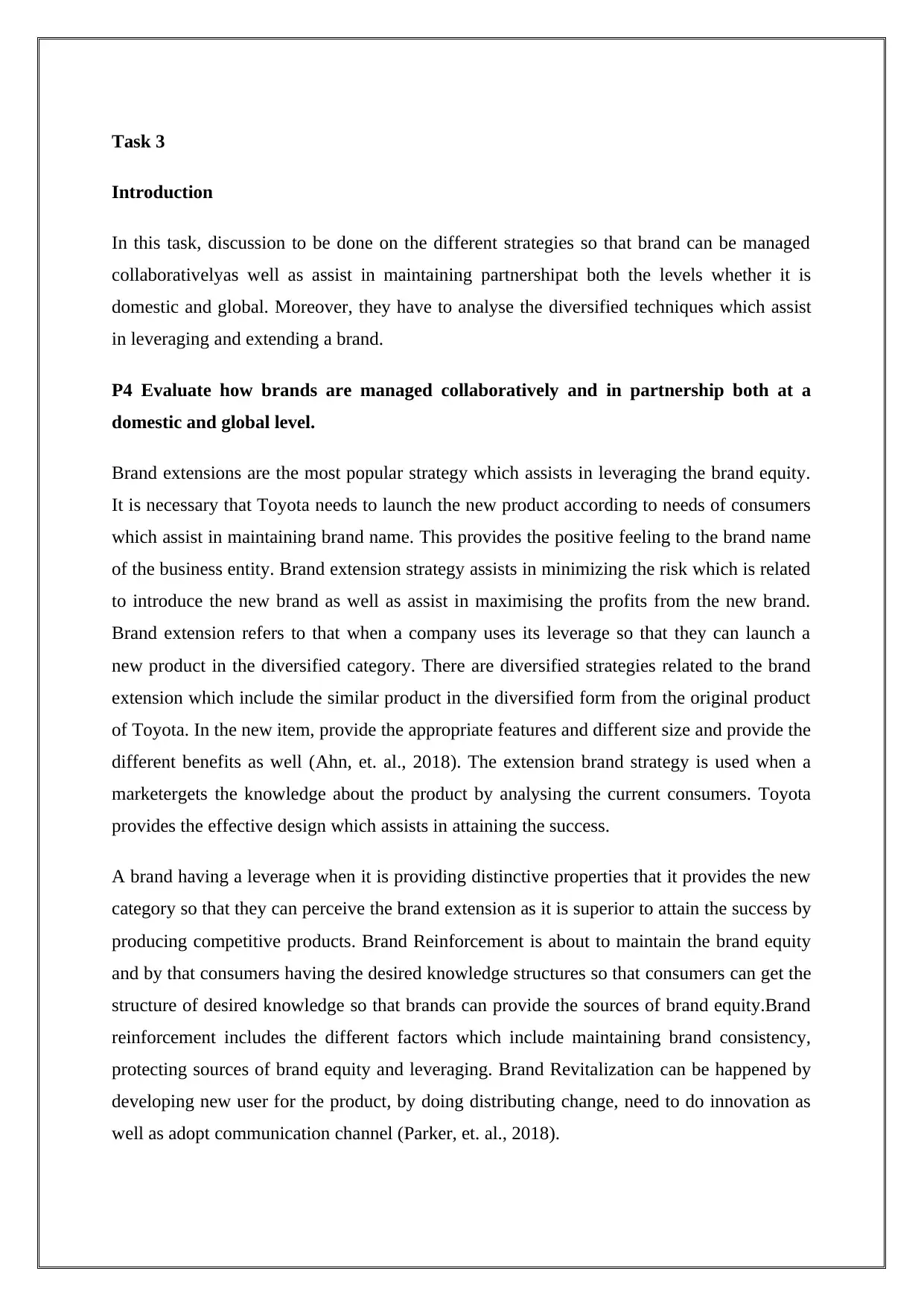
Task 3
Introduction
In this task, discussion to be done on the different strategies so that brand can be managed
collaborativelyas well as assist in maintaining partnershipat both the levels whether it is
domestic and global. Moreover, they have to analyse the diversified techniques which assist
in leveraging and extending a brand.
P4 Evaluate how brands are managed collaboratively and in partnership both at a
domestic and global level.
Brand extensions are the most popular strategy which assists in leveraging the brand equity.
It is necessary that Toyota needs to launch the new product according to needs of consumers
which assist in maintaining brand name. This provides the positive feeling to the brand name
of the business entity. Brand extension strategy assists in minimizing the risk which is related
to introduce the new brand as well as assist in maximising the profits from the new brand.
Brand extension refers to that when a company uses its leverage so that they can launch a
new product in the diversified category. There are diversified strategies related to the brand
extension which include the similar product in the diversified form from the original product
of Toyota. In the new item, provide the appropriate features and different size and provide the
different benefits as well (Ahn, et. al., 2018). The extension brand strategy is used when a
marketergets the knowledge about the product by analysing the current consumers. Toyota
provides the effective design which assists in attaining the success.
A brand having a leverage when it is providing distinctive properties that it provides the new
category so that they can perceive the brand extension as it is superior to attain the success by
producing competitive products. Brand Reinforcement is about to maintain the brand equity
and by that consumers having the desired knowledge structures so that consumers can get the
structure of desired knowledge so that brands can provide the sources of brand equity.Brand
reinforcement includes the different factors which include maintaining brand consistency,
protecting sources of brand equity and leveraging. Brand Revitalization can be happened by
developing new user for the product, by doing distributing change, need to do innovation as
well as adopt communication channel (Parker, et. al., 2018).
Introduction
In this task, discussion to be done on the different strategies so that brand can be managed
collaborativelyas well as assist in maintaining partnershipat both the levels whether it is
domestic and global. Moreover, they have to analyse the diversified techniques which assist
in leveraging and extending a brand.
P4 Evaluate how brands are managed collaboratively and in partnership both at a
domestic and global level.
Brand extensions are the most popular strategy which assists in leveraging the brand equity.
It is necessary that Toyota needs to launch the new product according to needs of consumers
which assist in maintaining brand name. This provides the positive feeling to the brand name
of the business entity. Brand extension strategy assists in minimizing the risk which is related
to introduce the new brand as well as assist in maximising the profits from the new brand.
Brand extension refers to that when a company uses its leverage so that they can launch a
new product in the diversified category. There are diversified strategies related to the brand
extension which include the similar product in the diversified form from the original product
of Toyota. In the new item, provide the appropriate features and different size and provide the
different benefits as well (Ahn, et. al., 2018). The extension brand strategy is used when a
marketergets the knowledge about the product by analysing the current consumers. Toyota
provides the effective design which assists in attaining the success.
A brand having a leverage when it is providing distinctive properties that it provides the new
category so that they can perceive the brand extension as it is superior to attain the success by
producing competitive products. Brand Reinforcement is about to maintain the brand equity
and by that consumers having the desired knowledge structures so that consumers can get the
structure of desired knowledge so that brands can provide the sources of brand equity.Brand
reinforcement includes the different factors which include maintaining brand consistency,
protecting sources of brand equity and leveraging. Brand Revitalization can be happened by
developing new user for the product, by doing distributing change, need to do innovation as
well as adopt communication channel (Parker, et. al., 2018).
⊘ This is a preview!⊘
Do you want full access?
Subscribe today to unlock all pages.

Trusted by 1+ million students worldwide
1 out of 23
Related Documents
Your All-in-One AI-Powered Toolkit for Academic Success.
+13062052269
info@desklib.com
Available 24*7 on WhatsApp / Email
![[object Object]](/_next/static/media/star-bottom.7253800d.svg)
Unlock your academic potential
Copyright © 2020–2025 A2Z Services. All Rights Reserved. Developed and managed by ZUCOL.



